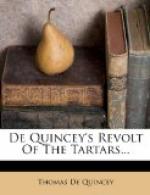sees the huge sheet of mist on the horizon, which,
as it rolls nearer and nearer, and its features become
more definite, reveals camels, and horses, and human
beings in myriads, and announces the advent of, etc.
etc.! In Kien Long’s own narrative
he is not there at all, having expected indeed the
arrival of the Kalmuck host, but having deputed the
military and commissariat arrangements for the reception
of them to his trusted officer, Chouhede; and his
first sight of any of them is when their chiefs are
brought to him, by the imperial post-road, to his
quarters a good way off, where they are honorably
entertained, and whence they accompany him to his summer
residence of Ge-hol. (2) De Quincey’s closing
account of the monument in memory of the Tartar transmigration
which Kien Long caused to be erected, and his copy
of the fine inscription on the monument, are not in
accord with the Chinese statements respecting that
matter. ’Mighty columns of granite and
brass erected by the Emperor Kien Long near the banks
of the Ily’ is De Quincey’s description
of the monument. The account given of the affair
by the mandarin Yu-min-tchoung, in his comment on
the Emperor’s Memoir, is very different.
’The year of the arrival of the Torgouths,’
he says, ’chanced to be precisely that in which
the Emperor was celebrating the eightieth year of the
age of his mother the Empress-Dowager. In memory
of this happy day his Majesty had built on the mountain
which shelters from the heat (Pi-chou-chan) a vast
and magnificent miao, in honor of the reunion
of all the followers of Fo in one and the same worship;
it had just been completed when Oubache and the other
princes of his nation arrived at Ge-hol. In memory
of an event which has contributed to make this same
year forever famous in our annals, it has been his
Majesty’s will to erect in the same miao
a monument which should fix the epoch of the event
and attest its authenticity; he himself composed the
words for the monument and wrote the characters with
his own hand. How small the number of persons
that will have an opportunity of seeing and reading
this monument within the walls of the temple in which
it is erected!’ Moreover the words of the monumental
inscription in De Quincey’s copy of it are hardly
what Kien Long would have written or could have authorized.
’Wandering sheep who have strayed away from the
Celestial Empire in the year 1616’ is the expression
in De Quincey’s copy for that original secession
of the Torgouth Tartars from their eastern home on
the Chinese borders for transference of themselves
far west to Russia, which was repaired and compensated
by their return in 1771 under their Khan Oubache.
As distinctly, on the other hand, the memoir of Kien
Long refers the date of the original secession to no
farther back than the reign of his own grandfather,
the Emperor Kang Hi, when Ayouki, the grandfather
of Oubache, was Khan of the Torgouths, and induced
them to part company with their overbearing kinsmen
the Eleuths, and seek refuge within the Russian territories
on the Volga. In the comment of the Chinese mandarin
on the Imperial Memoir the time is more exactly indicated
by the statement that the Torgouths had remained ‘more
than seventy years’ in their Russian settlements
when Oubache brought them back. This would refer
us to about 1700, or, at farthest, to between 1690
and 1700, for the secession under Ayouki.




